Filter by

Economic Growth, Biodiversity Conservation, and the Formation of Human Capita…
Can education play a role in fostering economic growth and simultaneously decrease pressure on forests? The aim of this study is to show that it can. Human capital formation is a key element in a development strategy that includes natural resource conservation within the framework of sustained economic growth and poverty alleviation. Consequently, it is not by chance that Guatemala is experienc…
- Edition
- -
- ISBN/ISSN
- 9783631526071
- Collation
- 266 halaman
- Series Title
- -
- Call Number
- 330 LON e
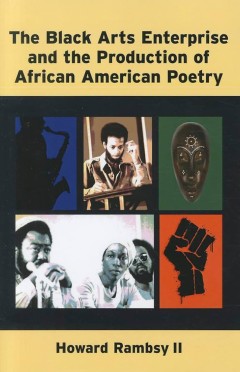
The Black Arts Enterprise and the Production of African American Poetry
The outpouring of creative expression known as the Black Arts Movement of the 1960s and 1970s spawned a burgeoning number of black-owned cultural outlets, including publishing houses, performance spaces, and galleries. Central to the movement were its poets, who in concert with editors, visual artists, critics, and fellow writers published a wide range of black verse and advanced new theories a…
- Edition
- -
- ISBN/ISSN
- 9780472117338
- Collation
- 198 halaman
- Series Title
- -
- Call Number
- 700 RAM b
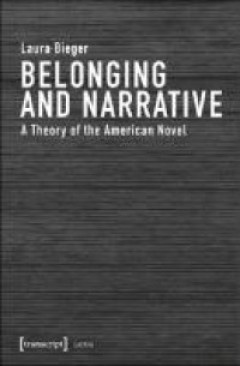
Belonging and Narrative : A Theory of the American Novel
Why did the novel become so popular in the past three centuries, and how did the American novel contribute to this trend? As a key provider of the narrative frames and formulas needed by modern individuals to give meaning and mooring to their lives. Drawing on phenomenological hermeneutics, human geography and social psychology, Laura Bieger contends that belonging is not a given; it is continu…
- Edition
- -
- ISBN/ISSN
- 9783839446003
- Collation
- -
- Series Title
- -
- Call Number
- 800 BIE b

Beastly Journeys : Travel and Transformation at the fin de siécle
A critical exploration of travel, animals and shape-changing in fin de siécle literature. Bats, beetles, wolves, butterflies, bulls, panthers, apes, leopards and spiders are among the countless creatures that crowd the pages of literature of the late nineteenth century. Whether in Gothic novels, science fiction, fantasy, fairy tales, journalism, political discourse, realism or naturalism, t…
- Edition
- -
- ISBN/ISSN
- 9781781386071
- Collation
- -
- Series Title
- Liverpool English Texts and Studies
- Call Number
- 809 YOU b

As If : Essays in As You Like It
Shakespeare’s As You Like It is a play without a theme. Instead, it repeatedly poses one question in a variety of forms: What if the world were other than it is? As You Like It is a set of experiments in which its characters conditionally change an aspect of their world and see what comes of it: what if I were not a girl but a man? What if I were not a duke, but someone like Robin Hood? What …
- Edition
- -
- ISBN/ISSN
- 9780615988177
- Collation
- -
- Series Title
- -
- Call Number
- 800 WES a
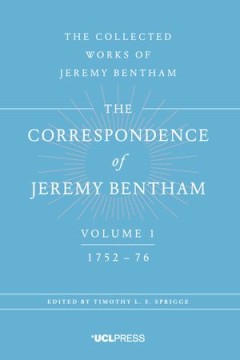
The Correspondence of Jeremy Bentham, Volume 1 : 1752 to 1776
The first five volumes of the Correspondence of Jeremy Bentham contain over 1,300 letters written both to and from Bentham over a 50-year period, beginning in 1752 (aged three) with his earliest surviving letter to his grandmother, and ending in 1797 with correspondence concerning his attempts to set up a national scheme for the provision of poor relief. Against the background of the debates on…
- Edition
- -
- ISBN/ISSN
- 9781911576037
- Collation
- -
- Series Title
- Correspondence of Jeremy Bentham 1
- Call Number
- 800 BEN c

The Correspondence of Jeremy Bentham, Volume 2 : 1777 to 1780
The first five volumes of the Correspondence of Jeremy Bentham contain over 1,300 letters written both to and from Bentham over a 50-year period, beginning in 1752 (aged three) with his earliest surviving letter to his grandmother, and ending in 1797 with correspondence concerning his attempts to set up a national scheme for the provision of poor relief. Against the background of the debates on…
- Edition
- -
- ISBN/ISSN
- 9781911576273
- Collation
- -
- Series Title
- Correspondence of Jeremy Bentham 2
- Call Number
- 800 BEN c
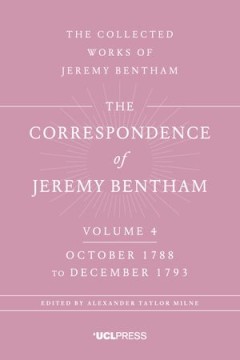
The Correspondence of Jeremy Bentham, Volume 4 : October 1788 to December 1793
The first five volumes of the Correspondence of Jeremy Bentham contain over 1,300 letters written both to and from Bentham over a 50-year period, beginning in 1752 (aged three) with his earliest surviving letter to his grandmother, and ending in 1797 with correspondence concerning his attempts to set up a national scheme for the provision of poor relief. Against the background of the debates on…
- Edition
- -
- ISBN/ISSN
- 9781911576150
- Collation
- -
- Series Title
- Correspondence of Jeremy Bentham 4
- Call Number
- 800 BEN c
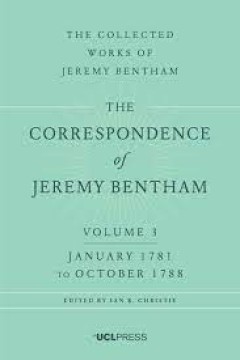
The Correspondence of Jeremy Bentham, Volume 3 : January 1781 to October 1788
The first five volumes of the Correspondence of Jeremy Bentham contain over 1,300 letters written both to and from Bentham over a 50-year period, beginning in 1752 (aged three) with his earliest surviving letter to his grandmother, and ending in 1797 with correspondence concerning his attempts to set up a national scheme for the provision of poor relief. Against the background of the debates on…
- Edition
- -
- ISBN/ISSN
- 9781911576099
- Collation
- -
- Series Title
- -
- Call Number
- 800 BEN c
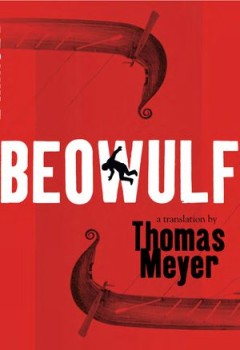
Beowulf : A Translation
Many modern Beowulf translations, while excellent in their own ways, suffer from what Kathleen Biddick might call “melancholy” for an oral and aural way of poetic making. By and large, they tend to preserve certain familiar features of Anglo-Saxon verse as it has been constructed by editors, philologists, and translators: the emphasis on caesura and alliteration, with diction and syntax smo…
- Edition
- -
- ISBN/ISSN
- 9780615612652
- Collation
- -
- Series Title
- -
- Call Number
- 800 MEY b
 Computer Science, Information & General Works
Computer Science, Information & General Works  Philosophy & Psychology
Philosophy & Psychology  Religion
Religion  Social Sciences
Social Sciences  Language
Language  Pure Science
Pure Science  Applied Sciences
Applied Sciences  Art & Recreation
Art & Recreation  Literature
Literature  History & Geography
History & Geography